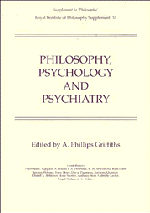Book contents
- Frontmatter
- Contents
- Preface
- Introduction: Just Getting Started
- Mind and Madness: New Directions in the Philosophy of Psychiatry
- Emotion and Memory: The Second Cognitive Revolution
- Meaning and Mechanism in Psychotherapy and General Psychiatry
- Making Sense on the Boundaries: On Moving Between Philosophy and Psychotherapy
- Mental Disorder, Illness and Biological Disfunction
- Integrity, Boundary and the Ecology of Personal Processes
- Multiple Personality and Computational Models
- Psychology and Politics: Lies, Damned Lies and Self-Deception
- Personal Identity and Psychiatric Illness
- Vices and the Self
- Wild Beasts and Idle Humours: Legal Insanity and the Finding of Fault
- Dangerousness and Mental Disorder
- Problems with the Doctrine of Consent
- Homosexuality
- Nietzsche and Music
- References
- Notes on Contributors
Problems with the Doctrine of Consent
Published online by Cambridge University Press: 03 May 2011
- Frontmatter
- Contents
- Preface
- Introduction: Just Getting Started
- Mind and Madness: New Directions in the Philosophy of Psychiatry
- Emotion and Memory: The Second Cognitive Revolution
- Meaning and Mechanism in Psychotherapy and General Psychiatry
- Making Sense on the Boundaries: On Moving Between Philosophy and Psychotherapy
- Mental Disorder, Illness and Biological Disfunction
- Integrity, Boundary and the Ecology of Personal Processes
- Multiple Personality and Computational Models
- Psychology and Politics: Lies, Damned Lies and Self-Deception
- Personal Identity and Psychiatric Illness
- Vices and the Self
- Wild Beasts and Idle Humours: Legal Insanity and the Finding of Fault
- Dangerousness and Mental Disorder
- Problems with the Doctrine of Consent
- Homosexuality
- Nietzsche and Music
- References
- Notes on Contributors
Summary
‘Law’ said Mr Justice Windeyer of the High Court of Australia, ‘marches with science, but to the rear, and limping a little’. Nowhere is this limping more apparent than in respect of the attempts to keep up with medical science. The media is full of reports of the use of fetal ova to create new life, of the transplant of animal parts into human bodies, of tests involving the consumption of radioactive materials by human subjects. The law's response to these problems has been notable most often by its absence. To some extent, the failure of the law to come to grips with developments is not entirely its own fault. Sometimes the advances made possible by science can only be forseen by those with a scientific background. At other times, however, the law fails by not being flexible enough to be able to create new categories of legal obligations. It tries instead to pigeon-hole radically new ideas within centuries-old categorisations. As anyone who has had experience with packing a large number of outsized objects into a too small suitcase will tell you, squeezing things into inappropriately shaped containers takes time. This is one of the problems apparent in the doctrine of consent; the area of law which attempts to regulate the provision of medical services by a practitioner to a patient.
The doctrine of consent within an English setting adopts two guises. One is an action for battery.
- Type
- Chapter
- Information
- Philosophy, Psychology and Psychiatry , pp. 191 - 196Publisher: Cambridge University PressPrint publication year: 1995

